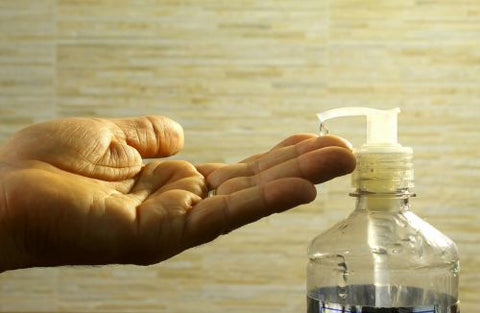
Hand sanitizer is not a replacement for hand washing. However, using a hand sanitizer with at least 60% alcohol can help prevent the spread of bacteria and viruses in situations where you can’t wash your hands [7]. It is also useful for use after hand washing or in-between hand washing.
There’s no debating that hand washing is much more effective than using hand sanitizer alone [7]. Handwashing with soap and water provides the most effective hand hygiene against COVID-19 [5]. It should always be the primary method of hand hygiene. When you need to disinfect your hands more frequently, hand sanitizer can be of help.

When it comes to hand sanitizers, an alcohol concentration between 60–95% is most effective [7]. Keep in mind, that they still may not work equally on all types of germs- some are resistant. Luckily, COVID-19 is not one of those types.
Here are some quick tips and useful points to consider when using hand sanitizer [7,5]:
Hand sanitizer is made of about 70% alcohol and 30% aloe vera gel, and other inactive ingredients to give it its consistency [4]. The alcohol used is usually ethyl alcohol. This is the same as rubbing alcohol and isopropyl alcohol, in this context.
Hand sanitizer works by dissolving the outer coating of microbes like bacteria and viruses [4]. Essentially, it burns off the microbe’s “skin.” Normal hand sanitizer will not burn your skin, but it may sting if you have a cut.
However, non-alcohol hand sanitizers do exist. Hand sanitizers with alcohol are much more effective than non-alcohol hand sanitizers [7].
US Food and Drug Administration (FDA), the Centers for Disease Control and Prevention (CDC), and the World Health Organization (WHO) have all issued special measures due to COVID-19 [5]. These organizations are allowing and even encouraging unregulated hand sanitizer production.
Their aim is to enable manufacturers who stock hand sanitizer ingredients and have them on hand to produce near-retail quality hand sanitizer during the shortage [5]. The FDA has even issued specific guidance instructing manufacturers on how to do so.
Hand sanitizer is an FDA over-the-counter-drug that cannot, under normal circumstances, be manufactured outside of an unregulated facility [6]. In these abnormal times, DIY hand sanitizer may be a great option for protecting yourself and preventing the spread of COVID-19.
You need a final alcohol dilution of at least 60% alcohol to be an effective hand sanitizer [1]. In DIY hand sanitizer, it is best to aim for 75% just to be safe. The best kind of alcohol for DIY hand sanitizer is 99% isopropyl alcohol (not industrial).
For a precision approach, you’ll need to perform some dilution math to figure out what your alcohol concentration will be after adding other ingredients. If your math is rusty, there are online calculators that can help.
If you would rather risk “eyeballing” it, you can also try these simple recipes [Ashworth]:
Mix three parts of alcohol with one part ale vera gel [1]. If desired, add two or three drops of tea tree oil. Supplies needed:
Aloe vera gel is very sticky on the skin [1]. That can be annoying and uncomfortable. If you have access to some other ingredients, a nicer DIY hand sanitizer spray can be made. Here is a list of the supplies you will need:
Making DIY hand sanitizers may seem like a good way to help in a time of crisis. However, there are some dangers to keep in mind [6]. The first is that hand sanitizers are usually made in FDA approved and regulated facilities. These facilities have stringent standards, standardized formulas, and standardized manufacturing ingredients.
DIY hand sanitizers are bound to be “a little off” in terms of their consistency. DIY hand sanitizer recipes simply lack the sophisticated manufacturing infrastructure to produce a standardized product. More concerning is that they could be off in their potency against microbes.
Simply put, the less alcohol, the more germs [6]. Likewise, worse quality alcohol, and there will also be less able to stop germs. Vodka is not an alternative to rubbing alcohol because it is only around 40% alcohol. Industrial grade 99% alcohol is used in cleaning electronics. However, this type of alcohol is much to harsh to be used on the skin.
Another concern is that the DIY hand sanitizer itself becomes contaminated and spreads germs onto you [6]. Homes are not like the sterile production facilities used to make real hand sanitizer. All homemade products have a higher risk of carrying germs into the final product.
Hand hygiene and face maks are critical steps to protect yourself from COVID-19 infection. Hand sanitizer has an important role in this as well. It is good to use before and after taking a face mask on or off. Also for using after you come in contact with shared surfaces like light switches and doorknobs.
To protect yourself from infection and prevent COVID-19 spread, you should disinfect your hands more frequently [3]. Excessive hand washing can cause skin irritation, so alternatives like hand sanitizer offer some comfort and safety. Finally, you should keep hand sanitizer accessible in high traffic areas. Doing this will encourage more frequent hand disinfection.
First, read the manufacturer’s directions on the bottle [CDC]. They will tell you exactly how their product is supposed to be used. Following the manufacturer’s directions will allow the hand sanitizer to work at its best. In general, you will apply the product to the palm of your hand. Then you will rub your hands together until they are dry. Some hand sanitizers may feel sticky after they dry because of the aloe vera ingredient or other inactive ingredients.
Finally, here are some basic tips for good hand hygiene [2]: